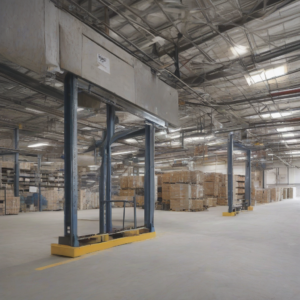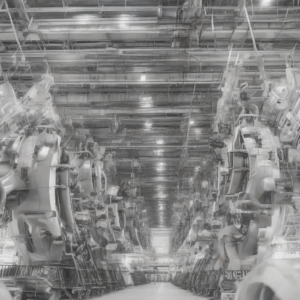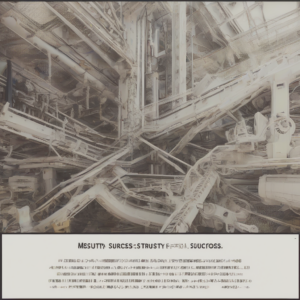Industrial Metal Stairs: A Deep Dive into Design, Materials, Safety, and Applications
Industrial metal stairs are ubiquitous in a wide range of settings, from factories and warehouses to power plants and refineries. Their robust construction and ability to withstand heavy use and harsh environments make them a crucial component of industrial infrastructure. This in-depth exploration delves into the various aspects of industrial metal stairs, covering design considerations, material choices, safety regulations, and diverse applications.
Design Considerations for Industrial Metal Stairs
The design of industrial metal stairs is governed by a multitude of factors, prioritizing safety, durability, and efficiency. Key considerations include:
- Traffic Load Capacity: The anticipated volume and weight of foot traffic are crucial. Designs must accommodate both typical and potentially heavier loads, such as equipment or materials being transported.
- Stair Rise and Run: Optimal rise (vertical height of each step) and run (horizontal depth of each step) dimensions are critical for safe and comfortable ascent and descent. Regulations often dictate acceptable ranges to prevent falls and fatigue.
- Handrails and Guardrails: Robust and securely affixed handrails and guardrails are paramount for safety. These must meet specific height and spacing requirements to prevent falls and provide adequate support.
- Landing Areas: Adequate landing areas at intervals along long stair flights are essential to prevent fatigue and allow for rest and safe turns. These landing areas should also meet size requirements for safe maneuvering.
- Staircase Width: Sufficient width ensures easy passage for multiple individuals simultaneously, particularly important in high-traffic areas. Regulations typically specify minimum widths based on anticipated user volume.
- Material Selection: The choice of metal and its finish significantly impacts durability, corrosion resistance, and aesthetic appeal. Considerations include steel, aluminum, and stainless steel, each offering different properties and cost implications.
- Accessibility Considerations: Compliance with accessibility regulations, such as ADA (Americans with Disabilities Act) standards, may require the incorporation of features like ramps or wider landings for wheelchair users.
- Environmental Factors: The operating environment must be considered. Factors such as exposure to moisture, chemicals, or extreme temperatures influence material selection and design to ensure longevity and prevent degradation.
- Modular Design: Modular design allows for flexibility and scalability. Pre-fabricated sections can be easily assembled and reconfigured as needed, adapting to changing spatial requirements.
- Maintenance Access: Design should consider access for inspection, maintenance, and repairs. This may involve incorporating features such as removable sections or easily accessible components.
Materials Used in Industrial Metal Stairs
The choice of metal for industrial stairs significantly impacts their performance and lifespan. Common materials include:
- Steel: Steel is a popular choice due to its high strength-to-weight ratio, cost-effectiveness, and weldability. However, it’s susceptible to corrosion unless properly treated with protective coatings such as galvanization or powder coating.
- Aluminum: Aluminum offers excellent corrosion resistance and lightweight properties, making it suitable for applications where weight is a concern. It’s generally more expensive than steel but requires less maintenance.
- Stainless Steel: Stainless steel provides exceptional corrosion resistance and durability, ideal for harsh environments. Its high cost is offset by its long lifespan and reduced maintenance requirements.
- Other Alloys: Specialized alloys may be used in specific applications to enhance properties such as strength, corrosion resistance, or resistance to extreme temperatures.
In addition to the metal itself, surface treatments play a crucial role in protecting the stairs and enhancing their appearance:
- Galvanization: A protective zinc coating applied to steel to prevent rust and corrosion.
- Powder Coating: A durable and aesthetically pleasing finish offering excellent protection against corrosion and wear.
- Painting: Provides a layer of protection and allows for customization of color and finish.
Safety Regulations and Standards for Industrial Metal Stairs
Industrial metal stairs must adhere to strict safety regulations and standards to minimize the risk of accidents. These regulations often vary by region and jurisdiction but typically cover aspects such as:
- Handrail Height and Spacing: Specific regulations define the required height and spacing of handrails to ensure safe gripping and prevent falls.
- Guardrail Height and Strength: Guardrails must meet specific height and strength requirements to prevent falls from the sides of the stairs.
- Step Dimensions: Regulations specify acceptable ranges for step rise and run to ensure comfortable and safe ascent and descent.
- Landing Area Dimensions: Minimum dimensions for landing areas are typically specified to provide safe resting points and allow for turns.
- Staircase Width: Regulations often specify minimum widths based on anticipated user volume.
- Slip Resistance: Stairs must have sufficient slip resistance to minimize the risk of falls, particularly in wet or oily conditions. This may involve the use of non-slip materials or textured surfaces.
- Lighting: Adequate lighting is essential for safe navigation, particularly in dimly lit areas.
- Regular Inspections: Regular inspections are required to identify and address any potential safety hazards.
- Compliance Certification: Compliance with relevant safety standards is often required and may involve professional certification or inspections.
Applications of Industrial Metal Stairs
Industrial metal stairs find wide-ranging applications across various sectors:
- Manufacturing Facilities: Access to elevated platforms, mezzanines, and machinery.
- Warehouses and Distribution Centers: Access to different levels of storage and operational areas.
- Power Plants and Refineries: Access to equipment, control panels, and elevated platforms.
- Construction Sites: Temporary access to different levels during construction projects.
- Mining Operations: Access to different levels within mining facilities.
- Oil and Gas Industries: Access to equipment and platforms in offshore and onshore facilities.
- Transportation Facilities: Access to elevated platforms and control areas in airports, train stations, etc.
- Public Works Infrastructure: Access to elevated areas for maintenance and inspection of bridges, tunnels, etc.
- Commercial Buildings: In some cases, used for access to mezzanines or elevated areas in industrial-style buildings.
Maintenance and Inspection of Industrial Metal Stairs
Regular maintenance and inspection are crucial to ensure the continued safety and longevity of industrial metal stairs. This involves:
- Regular Visual Inspections: Checking for signs of damage, corrosion, loose components, or wear and tear.
- Structural Integrity Checks: Periodic assessments of the structural integrity of the stairs to ensure they can safely support intended loads.
- Corrosion Prevention: Applying protective coatings or treatments to prevent corrosion and extend the lifespan of the stairs.
- Repair and Replacement: Prompt repair or replacement of damaged or worn components.
- Documentation: Maintaining comprehensive records of inspections, maintenance, and repairs.
Choosing the Right Industrial Metal Stairs
Selecting appropriate industrial metal stairs involves careful consideration of various factors:
- Application Requirements: Understanding the specific requirements of the application, such as traffic load, environmental conditions, and accessibility needs.
- Budgetary Constraints: Balancing cost-effectiveness with safety and durability.
- Material Selection: Choosing the right metal and finish based on performance requirements and environmental factors.
- Compliance with Regulations: Ensuring the stairs meet all relevant safety regulations and standards.
- Supplier Selection: Choosing a reputable supplier with experience in designing, manufacturing, and installing industrial metal stairs.
In conclusion, the design, materials, safety, and applications of industrial metal stairs are critical considerations for ensuring worker safety and operational efficiency across various industries. Understanding these factors is paramount for selecting and maintaining safe and durable stair systems.




